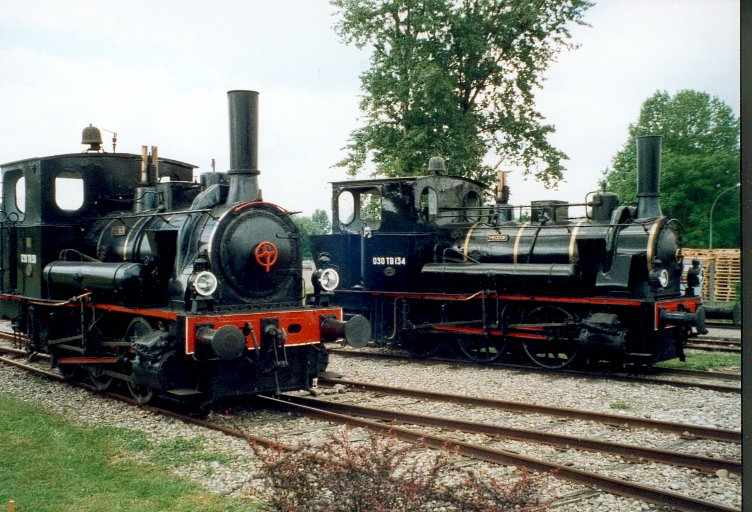General
characteristics of the locomotive:
| Builder: |
Elsässische
Maschinenfabrik Gesellschaft, Grafenstaden, Reichsland Elsaß |
| Model/Type: |
T3 |
| Date of delivery: |
1900 |
| Road number: |
6130 &
6134 |
| Steam pressure
[bar]: |
11 |
| Grate area [m2]: |
1,25 |
| Evaporative heating surface [m2]: |
firebox: 4,2, boiler: 65, Total:
69,2 |
| Superheating surface [m2]: |
- |
| Steam expansion: |
single |
| Number of
cylinders [-]: |
2 |
| Locomotive power
[kW]: |
ca.250 |
| Maximum starting
tractive effort [kN]: |
132 |
| Maximum safe
speed [km/h]: |
40 |
| Weight in working
order [t]: |
35,5 |
| Total length [m]: |
8,03 |
General view:

Builder plate:

Short presentation:
The
prussian 6100 are tank locomotives from prussian type T3, undergroup
D30, equipped with two
cylinders and from type single expansion engine without superheater.
Their 3 axles are coupled and the valve gear is from type Walschaerts.
They were equipped with the so-called Hardy and then reequipped with
the well-known Westinghouse air brake
after 1910.
The principal duty for which these
locomotives were designed was the every day switch on the yard. A very important
aspect of this use is the high reliability and the ease to use and
repair. Most reliable and simple
components had consequently to be used and the overall
design was aimed to be the most economical and robust. The original design
was the so-called "D22" dating back to 1882 and slightly modified to
increase power output. No wonder that even before their
production was ended, they were obsolete. But this was not a very
important point from the point of view of the operator.
This simplicity and robustness
explain why they were much in demand from private short lines after
they were put out of operation from their first owner. Not less than 13
exemplars found so a 2nd life, essentially in Alsace and in the greater
Paris.
History of the 130 & 134
before their restauration:
Before
nationalization of 1938, only #6125, 6130, 6132 and 6134 to 6137 are
left from the former serie 6101 to 6141. And only 3 locomotives will
find their way to the inventory of the SNCF: the 6125, 6130 &
6134
which became 030 TB 125, 130 & 134.
Our both locomotives belong to the
series and subcategories D26, D27, D29 and D30, which were built
between
1891 and 1900 and renumbered T3 after
1906. They belong to the subcategory D30 682
to 693. All these subcategories were compiled under the numbering T3
2073 to 2113
after 1906 and under the numbering T3 6101 to 6141
after
1912.
In the following the locomotives will be appointed under this
numbering.
A very old tradition of the
Imperial Railways was to baptize all the locomotives.
Consequently 6130 is named "Berthold" and 6134 has been
named "Theodor".
From end of WWII to may
1950, 6130 is working for the luxembourg national operator CFL (Chemins
de Fer Luxembourgeois) wearing number 30.00. In this time 6134 is
working in Strasbourg, shunting coal trains at the dedicated
railway station. After this period it is sent back to Sarrebourg in the
north of Alsace where its sister was working. Both were bought by
the "Aciéries d'Audincourt" (Steelworks from Audincourt) in 1958
and served there until 1970, when the company filed for
insolvency.
They were sold to a scrap
dealer named "Vernerey" with another locomotive built by Henschel
(which is not the one preserved by our association). In 1982
founding members of the CFTR found, bought and brought them
to Cernay near Mulhouse, to the branch line that a company placed
kindly at disposal.
Firebox and boiler of
6130 were in good condition (which is rare enough!) and this led to a
fast restoration in comparison with 6134 which was highly rusty. There
were also a lot a parts missing. However and despite this bad
condition, decision was made to preserve and restore this locomotive
too. In fact both machines were the most powerful locomotives from the
association and essential for the operation of the touristic trains
during summer time.
The certification body
(in France it is the so-called "'APAVE") requests a decennial check
(i.e. every 10 years). This check requires some
months to disassemble, control
and reassemble the whole locomotive. For this reason, every
steam locomotive can't be operated for a longer time, sometimes for
months (depending on how much time the volunteers have). During this
extensive check of the one locomotive, the other one can run and
operate the touristic train. So it's possible to show the public a 030
from the Imperial Railways in working condition without
interruption. In many aspects this decision was the right one.
Notice: both engines are
landmarked.
Career
at the CFTR:
| Last owner before preservation: |
Company "Vernerey" |
| Scrap Date: |
1981 |
| Acquisition date: |
1981 |
| Current owner: |
Privé |
| Restauration date (6130): |
1983 |
| Use: |
Runs the train to Sans-soucis and
back |
| Scrapping at the CFTR: |
- |
Pictures at the CFTR:

6132
at work in the suburb of Strasbourg during the 30's (Picture:
Henri Fohanno,
collection Raymond Floquet).

6130 stored on a
branch line of Cernay not far from Mulhouse, in 1983. (Picture:
Voies Ferrées No.17)

After its
restoration, 6130 is seen at the railway station of Volgelsheim in
2005. (Picture:
Sébastien Kieffer)

6134 at work in
2005.
(Picture: Sébastien Kieffer)
Bibliography and external links:
- Voies
Ferrées N°17
- Locomotives et
automotrices du réseau d'Alsace-Lorraine, Vauquesal-Papin,
Editions du Cabri, 1984
- Dampflokomotiven,
Bahnen in Elsaß-Lothringen,
wechselvolle Geschichte 1846 bis 1960, Lothar Spielhoff, Alba, 1991
Further technical
information:
.che





